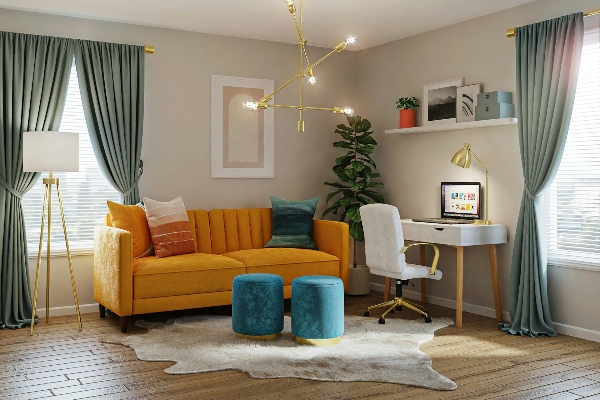Can a new paint job affect your mood and mentality? It could be. People have long associated color with emotion, which means the hues you surround yourself with can influence your psychology.
Knowing this adds a new wrinkle to home decor, but by learning the same tricks marketers use to influence purchasing behavior, you can create a unique atmosphere that says, “I’m home.” Consider the following when choosing paint shades to enhance your appearance and influence your mood.
Factors to consider when choosing an interior color
You’re not imagining things when there are light blue walls induce a sense of calm or relief, just as yellow accents can spark joy. Many people choose to fill their home with color for this reason. However, other qualities outside of psychology can influence your color choice. Here are three factors to consider when choosing interior colors.
1. Size of the room
Lighter shades make a small space appear larger. However, this doesn’t mean you shouldn’t use brighter shades in your home. When selecting, use a dark color for a tight space mirrors opposite windows and doorways to create a more spacious feeling.
2. Available lighting
Current LED lighting changes the atmosphere of your interior without repainting. For example, renters can escape the boring ‘greige’ by using strip lighting under cabinets and furniture to create a different colored glow.
3. Purpose of the room
You can use paint to create a sunny, vibrant atmosphere in your kitchen, but a serene, relaxing tone for your bedroom.
Understanding color qualities
Each shade is a rainbow assortment of different gradients, and the temperature and intensity of the scheme you choose are often just as important as the shade itself.
1. Color temperature
Warm tones with reddish or yellow undertones create a cheerful, extroverted atmosphere. Conversely, cooler undertones create a more serious, serene and relaxed atmosphere.
That’s why many people avoid cooler undertones for the kitchen, which is possible makes the room feel cold and unwelcoming. However, using a cool shade in the first bedroom can put you into a restful sleep.
2. Color intensity
Color intensity refers to the depth of the primary hue and affects its strength. For example, bright primary reds and yellows used in playground equipment reflect the overflowing energy of children. Meanwhile, a light canary yellow kitchen invites you to linger.
Financial institutions also use deep blue tones to convey tough reliability, while yoga studios may prefer pastels or neutral tones.

9 interior tones and their impact on your mood and psychology
You stand in the paint department in front of a dizzying array of swatches in every conceivable shade, intensity and temperature. How can you narrow your choice even further? Let’s see how specific interior colors affect your mood and psychology.
1. White
White has long stood for purity, a clean slate and possibilities. It is a backdrop for other colors, but can look plain without artwork to break the monotony.
2. Gray
Although gray is neutral, it is also halfway between white and black. As such, it creates security, balance and harmony. It also offsets more striking tones and provides deeper relaxation when combined with cool bedroom tones.
3. Tanning
Brown reflects the natural world. But like white, it can appear overly plain if not interrupted by other shades. It’s best to break the tan with an artistic photo collection or a unique work of art.
4. Red
Red is a color with a lot of energy, but can quickly provoke anger if used excessively. Bright reds work best as an accent color against neutral tones. Likewise, deeper magenta shades evoke sophisticated flavors, while pink exudes a sunny, childlike appearance.
5. Blue
Blue promotes tranquility, making it a popular choice for bedrooms. Making lighter blues rooms airy as the open airwhile darker shades convey the quiet serenity of the ocean depths.
6. Yellow
Yellow is reminiscent of the sun’s rays. It is a vibrant, warm and cheerful color in kitchens, living areas and children’s playrooms.
7. Greens
Like gray, green represents harmony and balance, but with warm undertones. It helps relieve stress without wasting your energy and promotes freshness.
8. Oranges
Orange combines the high energy of red with the optimism of yellow. However, it is also often used to express caution, so use it sparingly as an accent color or to bring some warmth to otherwise neutral spaces.
9. Purple
Purple is warmer than blue; the deep, intense shades indicate royalty and formality. However, lighter lavender shades pair well with greenery and create a relaxed, confident atmosphere.
The interior color and mood of your home
Do you need a new coat of paint to match your new outlook on life? Understanding how hue affects your mood can help you choose your home’s interior paint with psychology in mind. Through the magic of color science you can create the desired atmosphere in any room.
 Author biography
Author biography
Oscar Collins is editor-in-chief of Modified, where he writes about health, fitness and more. Follow him on Twitter @TModded for regular updates on his work.





